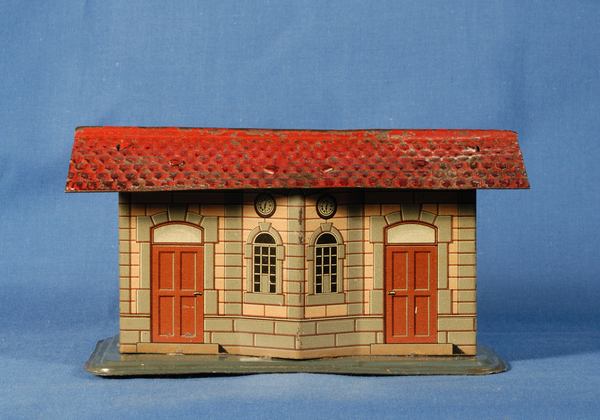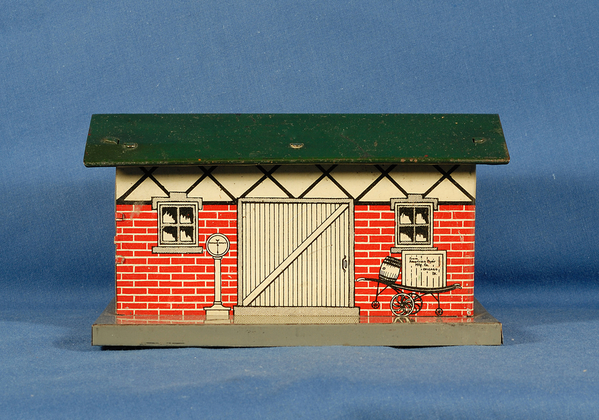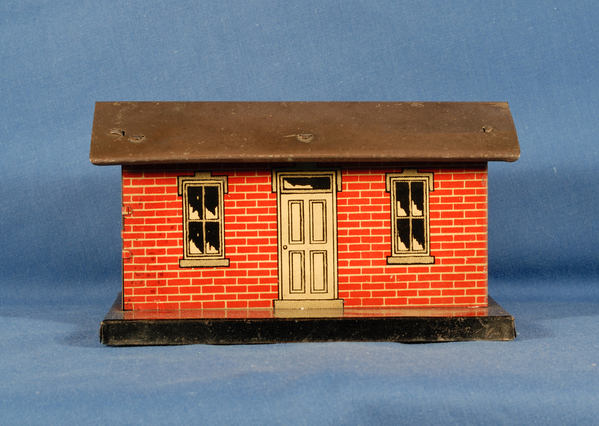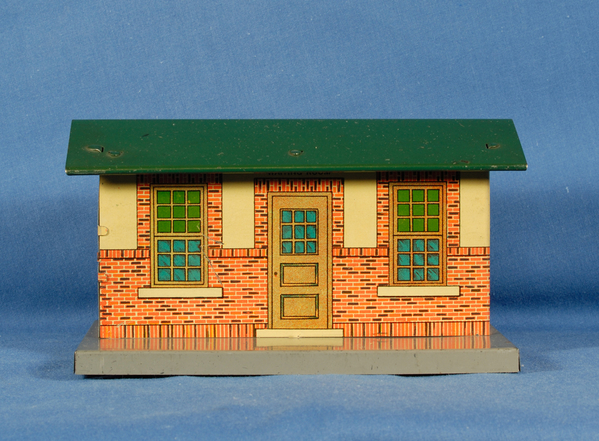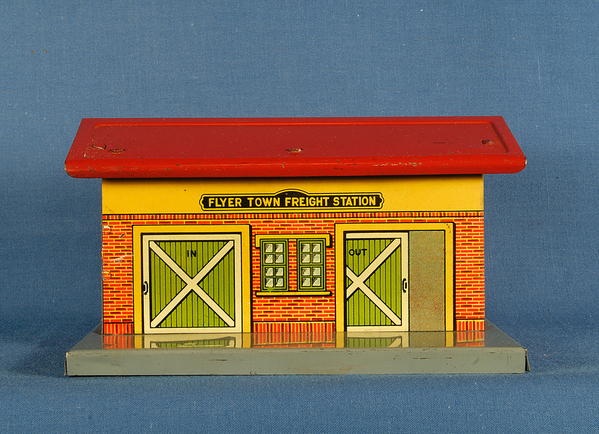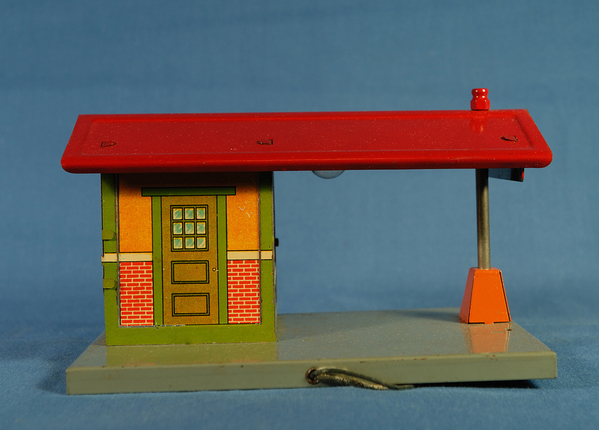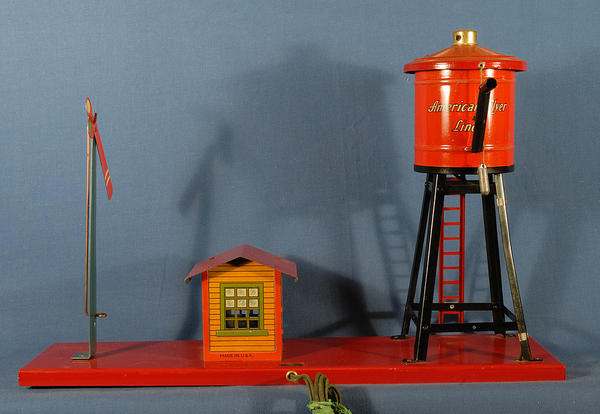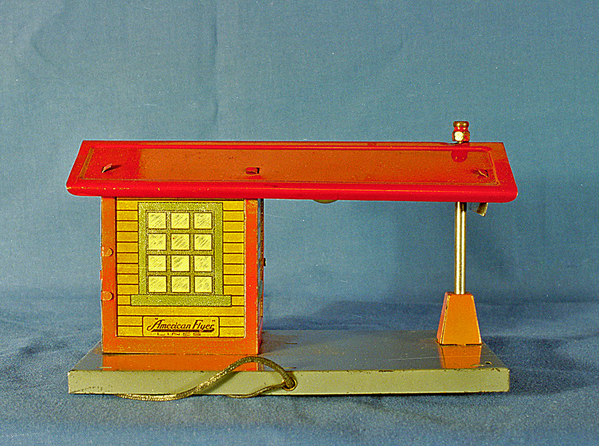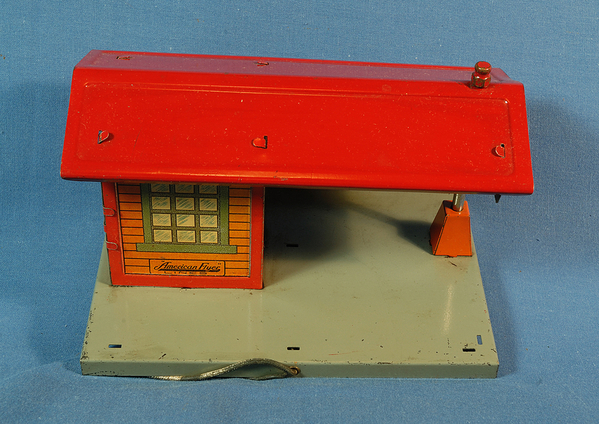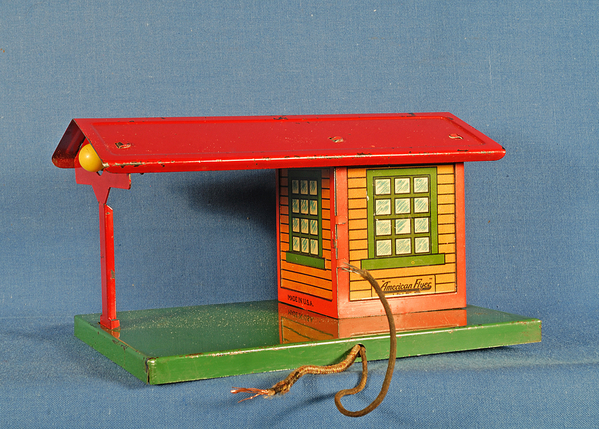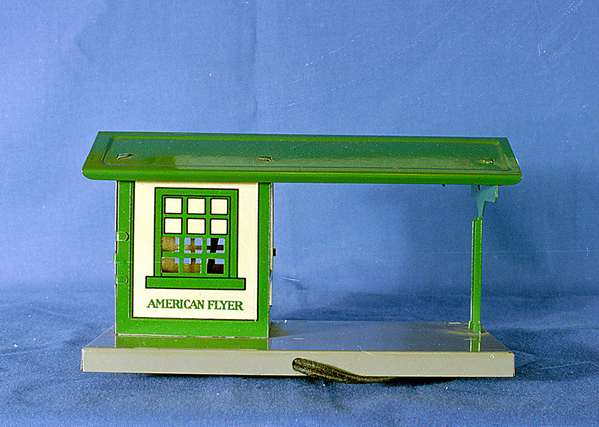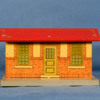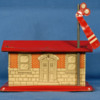There have been numerous comments in threads in the Tinplate Forum concerning the lack of detailed information about pre-war American Flyer Accessories. To the best of my knowledge, Leon Sweet was the first Tinplate Forum member to address this issue with his outstanding series of posts about the evolution of pre-war American Flyer Tunnels. It was his effort in this regard that has motivated me to try to do something similar with the evolution of the small American Flyer Stations. I hope what follows will provide you with some useful information and measure up to the standards Leon set.
In 1914 American Flyer cataloged the first of its very small stations. The initial offering in the 1914 catalog was designated M90 and was manufactured by KBN.
1914 M90 Catalog Illustration
The station below came with an early AF set and bears a strong resemblance to the catalog illustration. It may have been sold by American Flyer as an M90 but at this late date it is impossible to tell so, in the interest of accuracy, it is best to say the pictured station bears a strong resemblance to the catalog illustration.
In the first post from NWL following this post is a picture of a station that exactly matches the M90 in the illustration above. The station pictured in his post is the one that should be used for reference purposes.
Starting in 1918 American Flyer offered the first of its home-grown very small stations: #90 Passenger Station and #93 Freight Station
1918 Catalog Illustration
#93 Freight Station
#90 Freight Station
These stations, with various roof/base colors were offered in the catalogs between 1918 and 1923.
In 1924 the lithographic treatment for the #90 passenger station changed, however the #93 freight station retained its original look and was listed in the catalog through 1926.
1924/25 Catalog Illustration
#90 Passenger Station - New Lithography
In 1928 the number 93 was resurrected and assigned to a new, non-lighted, passenger station which joined #90 in the catalog lineup. This station had a covered passenger platform and a smooth green enameled roof. To the best of my knowledge #93 was offered in this form from 1928-1930.
Starting in 1928, along with station catalog numbers, American Flyer assigned names (in the catalog only) to the various stations. #90 was now listed as Hyde Park Station and #93 was listed as Suburban Station.
1928 Catalog Illustration
In 1929 the catalog text indicated the formerly smooth roof for the #90 was changed to an embossed roof (the catalog retained the old smooth roof illustration). While I've never seen an example of a #93 with an embossed roof, I would guess the roof for the 1929 version of the #93 was also embossed (Addendum - 4/10/20 - I guessed correctly ![]() - see picture in post added by NWL below).
- see picture in post added by NWL below).
#90 Hyde Park Station with embossed roof
In 1931 a new small freight station, #91 Fast Freight Station, was offered and included in some of the set illustrations for that year. It was also listed for separate sale as a footnote under the illustration and listing for the #90 station in the catalog accessory section. The #93 Suburban Station was dropped from the catalog listings.
1931 Catalog Set Illustration with #91 in background
1931 Catalog Listing of #90 and #91
Note: as in 1929 the catalog text states "embossed roof" but it's still the same old illustration.
#91 Fast Freight Station
In 1933 #91 was dropped from the station listing. Joining #90 Hyde Park in the catalog in the 1933 catalog was Suburban Station #234 which was just a resurrection of the old #93 but with an embossed roof and a station platform light under the station roof.
1933 Catalog Illustration
1933 #234 Suburban Station
You will note the catalog illustration of the #234 station has a green roof and that it is the mirror image of the #234 station shown above. I've never seen a #234 with a green roof but I have seen both the "mirror" image pictured above and #234 with the illustrated build. The reason for the two different orientations of the station has to do with the way the station base blanks were fed into the base edge bending press (we are assuming the holes were punched first). Depending on the direction of the bend the station house will be either on the left or right side of the base. This isn't the only station in the American Flyer line with mirror image construction - the long base #97 Freight Station suffered the same fate which is why you can find #97's with the crane either on the left or right side of the station.
1933 was the year Flyer changed the lithographic treatment of the small station houses that were part of the watchman's shanties on the new-for-1933 # 235 Water Tank Set and #236 Crossing Set (see catalog illustration above).
1933 #235 Water Tank Set - note the shed lithography.
While the #234 Suburban Station pictured above is a good match for the 1933 catalog illustration it was not the only version of the #234 made at that time. The second version is illustrated below and it has station side lithography that matches the lithographic treatment of the watchmen's shanties.
#234 with the 1933 watchman's shed lithography
One curious aspect of the #234 station pictured above is the station base
As you can see it has a number of extra holes for metal tabs. In fact, the unused tabs match the tab pattern for the tabs on the sides of the #90 Hyde Park Station. It appears American Flyer had a rather large number of leftover #90 bases which they reworked by feeding the bases into a hole punch press with settings for the tabs for the #234 Suburban Station (they also used these #90 bases for the crane base on the #97 American Flyer Long Base Freight Shed).
For whatever reason American Flyer did not use up all of the #90 station bases before moving on with new product. As a result you can find the #234 in all of its configurations and lithographic treatments with bases with hole punches just for #234 tabbing or with bases that are reworked #90 bases.
In 1934 American Flyer dropped the #90 Hyde Park station from their catalog listings.
A Momentary Digression - the NOT #90
Just for the sake of completeness - I'm including a picture of a station many individuals have identified as an American Flyer #90. For the record - it was made by Hafner and has the name "Glen Ellyn" on the station ends. It comes with the same lithographic pattern in a variety of colors and it can be found with and without the separate semaphore. Admittedly, without the semaphore the station does bear a good likeness to the American Flyer #90 but it is Hafner.
Hafner Glen Ellyn Station
...Now back to the main point of this post.
The catalog illustrations for the #234 for 1934, 1935, 1936, and 1937 are the same as the 1933 illustration. However, in 1936 the catalog called the #234 the New Suburban Station and the small illustration in the catalog supplement, while still showing the old #93 station lithography, indicates the station platform light was relocated from under the roof to a hole in the redesigned roof support.
1936 #234 with new roof post and light location
I suspect, but cannot prove, there is more to the "New" designation in the 1936 catalog besides the reworked support post and platform light. I think the situation for the "New" Suburban Station was much the same as when the lithography changed the watchmen's sheds back in 1933 which is to say, old station lithography was used up before a truly "New" Suburban Station was manufactured. My reason for saying this is because in the 1936 catalog American Flyer illustrated the #2004 New Crossing Set with Automatic Bell which sported a simplified green and white lithographic treatment for the watchman's shack.
1936 Catalog Illustration of #2004
Consequently, I think the the truly new New Suburban Station is the one illustrated below. I've seen this station and it's mirror image, I've seen it with red and green enameled roofs, and I've seen it with bases punched for just #234 tabbing and with reworked #90 station bases.
1936 New Suburban Station
The #234 station was last cataloged in 1938 and while the catalog illustration had the correct roof support and platform light position, it still did not have the correct station lithography. Sadly, by 1938 it was no longer considered "New" and was only listed as a plain old "Suburban Station."
1938 Catalog Illustration




